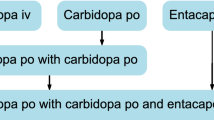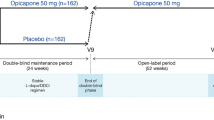Abstract
BIA 3-202 is a novel catechol-O-methyltransferase (COMT) inhibitor being developed for use as a levodopa-sparing agent in Parkinson’s disease. This study investigated the effect of four single oral doses of BIA 3-202 (50 mg, 100 mg, 200 mg, and 400 mg) compared with placebo on plasma concentrations of levodopa and its metabolite 3-O-methyl-levodopa (3-OMD) and on inhibition of erythrocyte COMT in healthy subjects receiving 100 mg of levodopa and 25 mg of benserazide (Madopar 125). This was a single-centre, double-blind, placebo-controlled, randomised, crossover study with five single-dose treatment periods. The washout period between doses was 2 weeks. On each treatment period, a different dose of BIA 3-202 or placebo was administered concomitantly with Madopar 125. Tolerability was assessed by recording adverse events, vital signs, continuous electrocardiogram and clinical laboratory parameters. In the study, 18 subjects (12 male and 6 female) participated. The drug combination was well tolerated. All doses of BIA 3-202 significantly increased the area under the concentration–time curve (AUC) versus placebo, ranging from 39% (95% confidence intervals, 1.06–1.69) with 50 mg to 80% (95% confidence intervals, 1.42–2.22) with 400 mg. No significant change in mean maximum plasma concentrations (Cmax) of levodopa was found. Mean Cmax and AUC of 3-OMD significantly decreased for all doses tested. BIA 3-202 caused a rapid and reversible inhibition of S-COMT activity, ranging from 57% (50 mg) to 84% (400 mg). In conclusion, the novel COMT inhibitor BIA 3-202 was well tolerated and significantly increased the bioavailability of levodopa and reduced the formation of 3-OMD when administered with standard release levodopa/benserazide.



Similar content being viewed by others
References
Hoehn MM (1992) The natural history of Parkinson’s disease in the pre-levodopa and post-levodopa eras. Neurol Clin 10:331–339
Olanow CW, Watts RL, Koller WC (2001) An algorithm (decision tree) for the management of Parkinson’s disease (2001) Treatment guidelines. Neurology 56:S1–S88
Paulson HL, Stern MB (1997) Clinical manifestations of Parkinson’s disease. McGraw Hill, Toronto
Nutt JG, Fellman JH (1984) Pharmacokinetics of levodopa. Clin Neuropharmacol 7:35–49
Gomes P, Soares-da-Silva P (1999) Interaction between L-DOPA and 3-O-methyl-L-DOPA for transport in immortalised rat capillary cerebral endothelial cells. Neuropharmacology 38:1371–1380
Chase TN (1998) The significance of continuous dopaminergic stimulation in the treatment of Parkinson’s disease. Drugs 55:1–9
Olanow W, Schapira AH, Rascol O (2000) Continuous dopamine-receptor stimulation in early Parkinson’s disease. Trends Neurosci 23:S117–S126
Factor SA, Molho ES, Feustel PJ, Brown DL, Evans SM (2001) Long-term comparative experience with tolcapone and entacapone in advanced Parkinson’s disease. Clin Neuropharmacol 24:295–299
Lambert D, Waters CH (2000) Comparative tolerability of the newer generation antiparkinsonian agents. Drugs Aging 16:55–65
Shepherd J, Clegg A (1999) Entacapone as an adjunctive treatment to levodopa in Parkinson’s disease. Development and Evaluation Committee Report No. 104. The Wessex Institute for Health Research and Development, Southampton, pp 1–50
Männistö PT (1994) Clinical potential of catechol-O-methyltransferase (COMT) inhibitors as adjuvants in Parkinson’s disease. CNS Drugs 1:172–179
Hauser RA, Molho E, Shale H, Pedder S, Dorflinger EE (1998) A pilot evaluation of the tolerability, safety, and efficacy of tolcapone alone and in combination with oral selegiline in untreated Parkinson’s disease patients. Tolcapone de novo study group. Mov Disord 13:643–647
Bonifácio MJ, Vieira-Coelho MA, Soares-da-Silva P (2003) Kinetic inhibitory profile of BIA 3-202, a novel fast tight-binding, reversible and competitive catechol-O-methyltransferase inhibitor. Eur J Pharmacol 460:163–170
Learmonth DA, Vieira-Coelho MA, Benes J, Alves PC, Borges N, Freitas AP, da-Silva PS (2002) Synthesis of 1-(3,4-dihydroxy-5-nitrophenyl)-2-phenyl-ethanone and derivatives as potent and long-acting peripheral inhibitors of catechol-O-methyltransferase. J Med Chem 45:685–695
Parada A, Loureiro AI, Vieira-Coelho MA, Hainzl D, Soares-da-Silva P (2001) BIA 3-202, a novel catechol-O-methyltransferase inhibitor, enhances the availability of L-DOPA to the brain and reduces its O-methylation. Eur J Pharmacol 420:27–32
Parada A, Soares-da-Silva P (2003) BIA 3-202, a novel catechol-O-methyltransferase inhibitor, reduces the peripheral O-methylation of L-DOPA and enhances its availability to the brain. Pharmacology 68:29–37
Soares-da-Silva P, Vieira-Coelho MA, Parada A (2003) BIA 3-202 is an effective inhibitor of erythrocyte and liver soluble catechol-O-methyltransferase and enhances the availability of L-DOPA to the brain. Pharmacol Toxicol 92:272–278
Almeida L, Soares-da-Silva P (2003) Pharmacokinetics and pharmacodynamics of BIA 3-202, a novel COMT inhibitor, during first administration to humans. Drugs R D 4:207–217
Schultz E, Nissinen E, Kaakkola S (1989) Determination of catechol-O-methyltransferase activity in erythrocytes by high performance liquid chromatography with electrochemical detection. Biomed Chromatogr 3:64–67
Vieira-Coelho MA, Soares-da-Silva P (1996) Ontogenic aspects of liver and kidney catechol-O-methyltransferase sensitivity to tolcapone. Br J Pharmacol 117:516–520
Vieira-Coelho MA, Soares-da-Silva P (1999) Effects of tolcapone upon soluble and membrane-bound brain and liver catechol-O-methyltransferase. Brain Res 821:69–78
Kaakkola S, Teravainen H, Ahtila S, Rita H, Gordin A (1994) Effect of entacapone, a COMT inhibitor, on clinical disability and levodopa metabolism in parkinsonian patients. Neurology 44:77–80
Dingemanse J, Jorga K, Zürcher G, Schmitt M, Sedek G, Da Prada M, Van Brummelen P (1995) Pharmacokinetic–pharmacodynamic interaction between the COMT inhibitor tolcapone and single-dose levodopa. Br J Clin Pharmacol 40:253–262
Keranen T, Gordin A, Karlsson M, Korpela K, Pentikainen PJ, Rita H, Schultz E, Seppala L, Wikberg T (1994) Inhibition of soluble catechol-O-methyltransferase and single-dose pharmacokinetics after oral and intravenous administration of entacapone. Eur J Clin Pharmacol 46:151–157
Sage JI, Mark MH (1994) Pharmacokinetics of continuous-release carbidopa/levodopa. Clin Neuropharmacol 17[Suppl 2]:S1–S6
Kurth MC, Adler CH (1998) COMT inhibition: a new treatment strategy for Parkinson’s disease. Neurology 50:S3–S14
Bonifati V, Meco G (1999) New, selective catechol-O-methyltransferase inhibitors as therapeutic agents in Parkinson’s disease. Pharmacol Ther 81:1–36
Kaakkola S (2000) Clinical pharmacology, therapeutic use and potential of COMT inhibitors in Parkinson’s disease. Drugs 59:1233–1250
Author information
Authors and Affiliations
Corresponding author
Rights and permissions
About this article
Cite this article
Silveira, P., Vaz-da-Silva, M., Almeida, L. et al. Pharmacokinetic–pharmacodynamic interaction between BIA 3-202, a novel COMT inhibitor, and levodopa/benserazide. Eur J Clin Pharmacol 59, 603–609 (2003). https://doi.org/10.1007/s00228-003-0680-5
Received:
Accepted:
Published:
Issue Date:
DOI: https://doi.org/10.1007/s00228-003-0680-5




